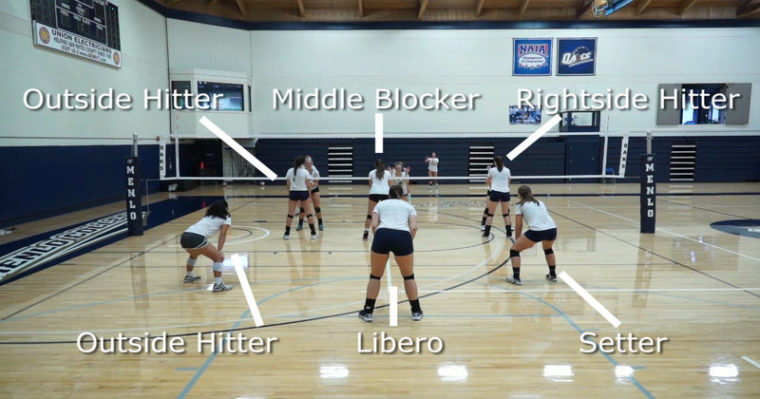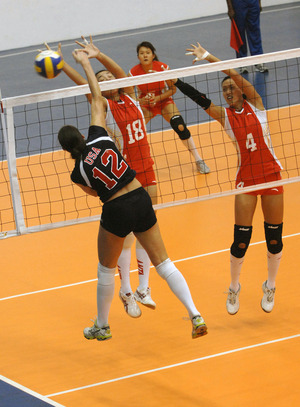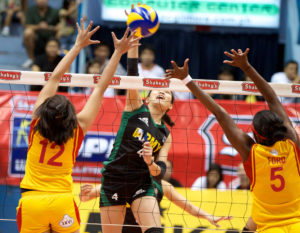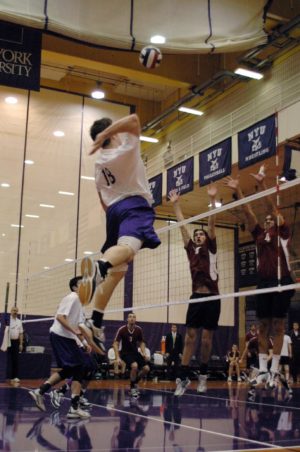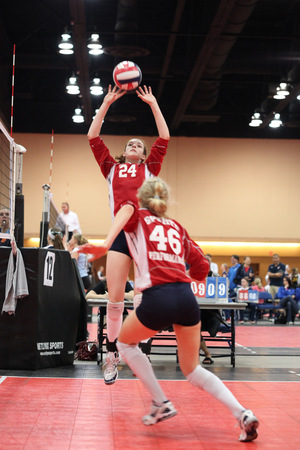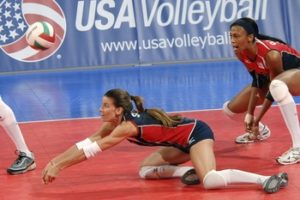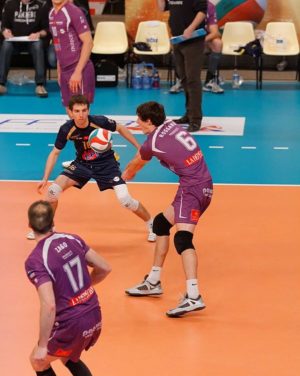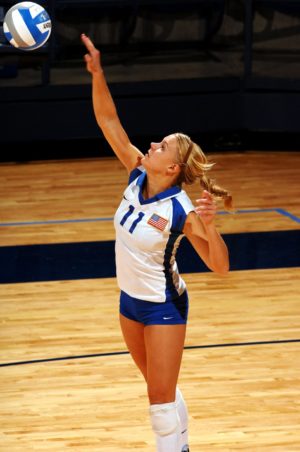Volleyball Positions: Opposite Hitter Characteristics – What makes a great opposite hitter?
A great opposite hitter is a volleyball player who isn’t afraid to do the dirty work. They make their presence known when they’re up at the net and play aggressively when they drop back on defense. The 5 most common traits of a great opposite hitter are:
- Height – People assume that middle hitters are the tallest volleyball players but that isn’t necessarily true. Great opposite hitters are usually enormous because it’s a volleyball position centered around blocking. By controlling the opposing outside hitter, you give your team a great chance to win.
- Power – SWING HARD! Tipping can be beneficial in certain situations but great opposite hitters are almost always larger than whoever is blocking them. Because of this, they need to have the power necessary to put the ball down and not get dug.
- Strong Hands – Similar to the middle, the opposite hitter will be doing a ton of blocking. It’s crucial that they have strong hands or else they will be in for a difficult volleyball season.
- Court Awareness – Opposite Hitters play defense on the line so they are responsible for deciding if a spike is in or out. Top notch court awareness is a must have!
- Grit – Let’s face it, opposite hitters are in the danger zone on defense. Whether it is a one ball from the opposing middle or a hard line shot from the outside, an outside hitter has to be ready and willing to take a volleyball to the face.
Volleyball Positions: Setter Characteristics – What makes a great setter?
Setter is the most important of the volleyball positions. Great setters are the whole package and ooze leadership. They’re the first to get the blame and last to get the praise but if a team has a great setter, they have a great shot at winning. The 5 most common traits of a great setter are:
- Athleticism – Outside of the fact that setters are asked to do everything (pass, dig, set, hit, etc.) they also run the most in any given volleyball game. Unless the team passes perfectly every single time, it’s likely the setter will be running quite a bit.
- High Volleyball IQ – A great setter is like a great chess player; they’re always one step ahead of their opponent. In order to become one of the best, you need to understand the thought process of opposing players. Once you do that, you can manipulate your offense and play to your team’s strengths.
- Strong Hands – This one is obvious. A great setter needs strong hands to push the ball to where it needs to be. Weak hands leads to the ball slipping through your fingertips and points for the other team. Not too mention, blocking is a big part of being a great setter!
- Consistency – If the setter has a bad day, the offense has a bad day. To be a great setter you must be consistent. A lot of this will have to do with team chemistry but it’s important for hitters to trust that the volleyball will in the right spot.
- Leadership – Leadership is easily the most important characteristic of a great setter. The best know how to pick their team up and fight back when all hope is lost. Setters often get the blame so be ready to accept it for the good of the team.
Volleyball Positions and Rotations – Volleyball Rotations for Beginners
It’s common to hear beginner volleyball players ask, “what are volleyball rotations?”. If this sounds like you, don’t worry! We’re here to help you out!
For starters, the volleyball rotations are just the position a certain player starts in before the serve. Once the ball is served, players are free to move anywhere on the court and won’t be called for an out of rotation violation.
Think of the volleyball rotations like a circle that has six stations. Every time your team sides out, a new server must serve so each player moves clockwise to a new station. The biggest thing to remember is who is to your left and who is to your right. If you make sure they always stay to each side of you, you’ll never be out of rotation.
Often times, young players are given a rotation sheet and asked to memorize their position on the volleyball court. This can be incredibly overwhelming for beginner players. While memorizing can be helpful, it’s important to always know “teammate A is to my left and teammate B is to my right”.
Stuff to Buy!
As always, we like to suggest a few products that you can get on your quest to becoming a great volleyball player. In order to give readers the best experience possible, the Volleyball-Tips team continues to provide free content without any ads. In order to keep this up, we need your support!
Any time that you are looking to purchase something online (even if it is not volleyball related), do so by clicking one of our links and get it on Amazon. This will have no impact on your purchasing price but Amazon will give us a cut for getting them a customer. Trust us, this helps big time and let’s us spread the great game of volleyball to everyone with internet access! Thanks for being a reader!
Best Volleyball Knee Pads
The three volleyball knee pads shown above are some of the best on the market. Take a look below for a bit of detail about each. For a more complete review, click here!
Mizuno LR6 – The Mizuno LR6 volleyball knee pads are a phenomenal choice if you’re looking for something that won’t impact your ability to jump. At a sleeve length of six inches, they are one of the smallest options available on the market. This makes them a great choice for players who play in both the front row and back row.
Although they provide a great deal of protection, they may not be the best option for a full-time back row player such as a libero or defensive specialist. These types of players may be a better fit for a volleyball knee pad that provides a bit more padding in order to prevent injury.
Nike Streak – If you’re looking to purchase Nike volleyball knee pads, your best bet is to go with the Nike Streaks. Similar to the Mizuno LR6 knee pads, the Nike streak knee pads provide excellent coverage without restricting your ability to move. They are used by college teams all over the country (if they are sponsored by Nike) so there are plenty of players who would recommend them.
As mentioned above, They won’t restrict your ability to move but it is at the cost I’m providing additional padding. If you are a back row player, it might be a better idea to go with one of the thicker knee pads on the market.
ASICS Slider – The ASICS slider knee pads are likely the best choice for players who find themselves on the ground multiple times a game. This is because they offer a great deal of protection and padding in order to prevent bumps, bruises and injuries. If you’re new to the game or you’re just looking for extra protection because you play exclusively in the back row, these knee pads are probably what you should purchase.
It is worth noting that the extra protection may limit a bit of your movement as compared to the other two choices above. ASICS did a great job with their design but if you play in the front row, one of the other options would be a better fit.
Frequently asked questions about Volleyball Positions
Does height matter when choosing a volleyball position?
Yes and no. New players should not feel as though they need to lock themselves into a certain volleyball position right from the start. If you are a shorter player but love to hit the ball, don’t let your height discourage you. Plenty of players make up for their height by increasing their vertical jump or finding creative ways to beat blocks.
With that being said, it is quite difficult to be a dominant hitter if you are on the shorter side. The average height for each position from shortest to tallest is as followed: libero/defensive specialist, setter, outside hitter, opposite hitter, middle hitter.
What are the best volleyball positions for short players?
In terms of practicality, the best volleyball positions for shorter players tend to be libero and defensive specialist. This is because they do not require any blocking or hitting thus eliminating the need to get over the height of the net.
Regardless of height it is incredibly important for all volleyball players to work on both quickness and technique. Just because you weren’t gifted with a 6’10 frame doesn’t mean you can’t win at the net. Work on your craft because every single rep counts.
What are the best volleyball positions for tall players?
Tall players tend to gravitate more towards middle hitter and opposite hitter because of the blocking aspect of the game. Both volleyball positions are required to stop the opposing team’s attack so it is imperative to have the reach necessary to do so.
If you’re not the tallest volleyball player but still want to hit, outside hitter could be a great position for you. It’s not as focused on blocking as middle and opposite but still has a huge impact on a team’s offense.
What is the best volleyball position for me?
One of the first questions a new player asks when they step on the court is, “where should I play?”. The answer is it really depends on where you want to take volleyball. If you are just starting out, try everything and pick your favorite. It is important to know the intricacies of each position in order to become a well rounded player.
If you are a bit more serious and want to make volleyball a part of your future, the first thing to think about is your height or estimated adult height if you are young. Shorter volleyball players should lean towards libero or defensive specialist and work on their agility and reaction time. If you know you are going to be very tall, lean towards middle hitter or opposite hitter and work on lateral movement and reach. If you are not sure, the best bet is outside because you will be exposed to all aspects of volleyball. With that being said, make the decision for yourself! Don’t let anyone else tell you that you’re too short to play a certain position. Work hard and show them why you’re great!
